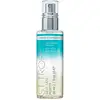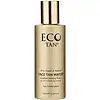What's inside
What's inside
 Key Ingredients
Key Ingredients

 Benefits
Benefits

 Concerns
Concerns

 Ingredients Side-by-side
Ingredients Side-by-side

Water
Skin ConditioningDihydroxyacetone
Skin ConditioningPEG-40 Hydrogenated Castor Oil
EmulsifyingPhenoxyethanol
PreservativeBenzyl Alcohol
PerfumingGlycerin
HumectantSaccharide Isomerate
HumectantCitrus Nobilis Fruit Extract
MaskingSodium Metabisulfite
AntioxidantParfum
MaskingPanthenol
Skin ConditioningHydrolyzed Hyaluronic Acid
HumectantLinalool
PerfumingButylene Glycol
HumectantLimonene
PerfumingHexyl Cinnamal
PerfumingCitronellol
PerfumingHibiscus Sabdariffa Flower Extract
Skin ConditioningCitric Acid
BufferingSodium Citrate
BufferingPotassium Sorbate
PreservativeWater, Dihydroxyacetone, PEG-40 Hydrogenated Castor Oil, Phenoxyethanol, Benzyl Alcohol, Glycerin, Saccharide Isomerate, Citrus Nobilis Fruit Extract, Sodium Metabisulfite, Parfum, Panthenol, Hydrolyzed Hyaluronic Acid, Linalool, Butylene Glycol, Limonene, Hexyl Cinnamal, Citronellol, Hibiscus Sabdariffa Flower Extract, Citric Acid, Sodium Citrate, Potassium Sorbate
Aloe Barbadensis Leaf Juice
Skin ConditioningDihydroxyacetone
Skin ConditioningGlycerin
HumectantCaprylyl/Capryl Glucoside
CleansingLeuconostoc/Radish Root Ferment Filtrate
AntimicrobialSodium Hyaluronate
HumectantPelargonium Graveolens Oil
MaskingCitrus Aurantium Dulcis Peel Oil
MaskingGlyceryl Caprylate
EmollientSodium Cocoyl Glutamate
CleansingDehydroxanthan Gum
Emulsion StabilisingPolyglyceryl-6 Oleate
EmulsifyingSodium Surfactin
CleansingCitric Acid
BufferingLimonene
PerfumingCitronellol
PerfumingGeraniol
PerfumingAloe Barbadensis Leaf Juice, Dihydroxyacetone, Glycerin, Caprylyl/Capryl Glucoside, Leuconostoc/Radish Root Ferment Filtrate, Sodium Hyaluronate, Pelargonium Graveolens Oil, Citrus Aurantium Dulcis Peel Oil, Glyceryl Caprylate, Sodium Cocoyl Glutamate, Dehydroxanthan Gum, Polyglyceryl-6 Oleate, Sodium Surfactin, Citric Acid, Limonene, Citronellol, Geraniol
 Reviews
Reviews

Ingredients Explained
These ingredients are found in both products.
Ingredients higher up in an ingredient list are typically present in a larger amount.
Citric Acid is an alpha hydroxy acid (AHA) naturally found in citrus fruits like oranges, lemons, and limes.
Like other AHAs, citric acid can exfoliate skin by breaking down the bonds that hold dead skin cells together. This helps reveal smoother and brighter skin underneath.
However, this exfoliating effect only happens at high concentrations (20%) which can be hard to find in cosmetic products.
Due to this, citric acid is usually included in small amounts as a pH adjuster. This helps keep products slightly more acidic and compatible with skin's natural pH.
In skincare formulas, citric acid can:
While it can provide some skin benefits, research shows lactic acid and glycolic acid are generally more effective and less irritating exfoliants.
Most citric acid used in skincare today is made by fermenting sugars (usually from molasses). This synthetic version is identical to the natural citrus form but easier to stabilize and use in formulations.
Read more about some other popular AHA's here:
Learn more about Citric AcidCitronellol is used to add fragrance/parfum to a product. It is often derived from plants such as roses. In fact, it can be found in many essential oils including geranium, lavender, neroli, and more. The scent of Citronellol is often described as "fresh, grassy, and citrus-like".
Since the Citronellol molecule is already unstable, Citronellol becomes irritating on the skin when exposed to air.
Citronellol is a modified terpene. Terpenes are unsaturated hydrocarbons found in plants. They make up the primary part of essential oils.
Citronellol is not able to be absorbed into deeper layers of the skin. It has low permeability,
Citronellol is also a natural insect repellent.
Learn more about CitronellolDihydroxyacetone, or DHA, is a simple sugar. It is frequently used in self-tanning products.
DHA binds to the amino acids in your dead skin cells to create a brown/orange color. Darkening begins to kick in a few hours after application and will continue to develop for up to 3 days. This ingredient can be drying.
Both the US and the EU have approved DHA in self-tanning products. In the EU, DHA is allowed at a maximum concentration of 10%. Most tanning products usually contain amounts between 3-5%.
If you are pregnant or have underlying medical conditions, it is best to speak with a dermatologist about using self-tanning products.
Learn more about DihydroxyacetoneGlycerin is already naturally found in your skin. It helps moisturize and protect your skin.
A study from 2016 found glycerin to be more effective as a humectant than AHAs and hyaluronic acid.
As a humectant, it helps the skin stay hydrated by pulling moisture to your skin. The low molecular weight of glycerin allows it to pull moisture into the deeper layers of your skin.
Hydrated skin improves your skin barrier; Your skin barrier helps protect against irritants and bacteria.
Glycerin has also been found to have antimicrobial and antiviral properties. Due to these properties, glycerin is often used in wound and burn treatments.
In cosmetics, glycerin is usually derived from plants such as soybean or palm. However, it can also be sourced from animals, such as tallow or animal fat.
This ingredient is organic, colorless, odorless, and non-toxic.
Glycerin is the name for this ingredient in American English. British English uses Glycerol/Glycerine.
Learn more about GlycerinLimonene is a fragrance that adds scent and taste to a formulation.
It's found in the peel oil of citrus fruits and other plants such as lavender and eucalyptus. The scent of limonene is generally described as "sweet citrus".
Limonene acts as an antioxidant, meaning it helps neutralize free radicals.
When exposed to air, oxidized limonene may sensitize the skin. Because of this, limonene is often avoided by people with sensitive skin.
The term 'fragrance' is not regulated in many countries. In many cases, it is up to the brand to define this term. For instance, many brands choose to label themselves as "fragrance-free" because they are not using synthetic fragrances. However, their products may still contain ingredients such as essential oils that are considered a fragrance.
Learn more about Limonene